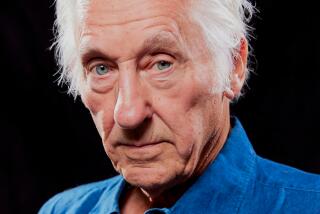No one to please but himself
John Szarkowski put himself out to pasture in 1991, ending a 29-year career as director of photography at the Museum of Modern Art in New York. He returned to the art world 14 years later, but as an artist. A retrospective exhibition of his photographs opened at the San Francisco Museum of Modern Art in 2005 and traveled to four other museums, including MoMA.
For people who knew Szarkowski only as a tastemaker and gatekeeper -- one who defined photography as a modern art form and introduced the public to artists such as Diane Arbus, Garry Winogrand, Lee Friedlander and William Eggleston -- it was a strange turn of events. Some suspected that he had taken up photography as a retirement hobby and had called in favors to promote himself.
But the exhibition revealed that he had been a highly accomplished artist in his early days. He had received two Guggenheim Fellowships, had exhibited his work at leading museums and had published two critically acclaimed photography books -- “The Idea of Louis Sullivan,” an impassioned tribute to the buildings and philosophy of a major American architect, and “The Face of Minnesota,” a richly textured portrait of the Midwestern state -- before becoming a curator. In fact, with the San Francisco show, Szarkowski, after a 29-year hiatus, was returning to his vocation.
This week, part of that story will come to Los Angeles. Szarkowski will give a public lecture, “Being a Photographer,” Thursday night at the J. Paul Getty Center, and a mini-retrospective of his photographs will open Saturday at the Peter Fetterman Gallery in Bergamot Station.
“It was an adventure,” Szarkowski says of his return to picture making, speaking by telephone from his home on an apple farm in upstate New York. “Not that I didn’t enjoy my work at the museum. It was very interesting and challenging, not to mention educational, but it was different from trying to make sense of the world with my own work.”
He had to get over “a certain awkwardness,” he says. “In terms of easy technical competence, I don’t think I’m as good now as I was when I was 30. When you are young and work 18 hours a day, you can do an awful lot of consistently good work with ease.”
His pictures from the Louis Sullivan book “define architecture as a living thing, subtly responsive to natural light and a grand, mutable stage for human interaction,” New York Times critic Roberta Smith wrote in a review of the retrospective at MoMA. In recent years, he has favored rural landscapes, depicting old barns and apple trees with loving attention to detail.
“There is a strong continuity, but only with part of what I did earlier,” he says. “When I was young, I had a stronger sense that, in addition to being an artist, I was supposed to be a good citizen. The things I devoted my energies to had some direct social valence. They might be not only artistically valid but win me some points as a good person. I’m 80. If I haven’t won those points by now, it’s too late.”
Szarkowski still wants his work to be “useful,” but his definition of the term has changed.
“I did the Louis Sullivan project with a sense of wanting to persuade,” he says. “Here were a great artist, great buildings and ideas that deserved closer attention.
“A large component of ‘The Face of Minnesota’ was to demonstrate what a wonderful and beautiful place it is. I might wish I was that person still, but I’m not. I don’t feel the obligation. I decided I could concentrate on issues that I thought were important in a more personal way.”
Other photographers have taught him a lot, he says, especially French artist Eugene Atget, who photographed late 19th and early 20th century Paris. As Szarkowski became intimately acquainted with Atget’s work, he confronted what he calls “the constantly revised problem of how to get the picture right when one’s understanding of the subject is continually changing.”
Like Atget’s Parisian shop windows, Szarkowski’s apple trees look different every day.
So what’s next?
“Farm animals, old-fashioned ones,” he says. Dairy herds have disappeared from his rural area, but some new neighbors have brought in an assortment of animals. Nobody sees chickens anymore, except at the supermarket, he says. That’s about to change.
*
*
‘Being a Photographer’
Where: Harold M. Williams Auditorium, J. Paul Getty Center, 1200 Getty Center Drive, Los Angeles
When: 7-8 p.m. Thursday
Price: Free; reservation required
Contact: (310) 440-7300; www.getty.edu
Also
What: “John Szarkowski,” Saturday through Dec. 30 at Peter Fetterman Gallery, 2525 Michigan Ave., A7, Santa Monica, (310) 453-6463; www.peterfetterman.com
More to Read
The biggest entertainment stories
Get our big stories about Hollywood, film, television, music, arts, culture and more right in your inbox as soon as they publish.
You may occasionally receive promotional content from the Los Angeles Times.










